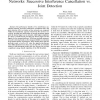Free Online Productivity Tools
i2Speak
i2Symbol
i2OCR
iTex2Img
iWeb2Print
iWeb2Shot
i2Type
iPdf2Split
iPdf2Merge
i2Bopomofo
i2Arabic
i2Style
i2Image
i2PDF
iLatex2Rtf
Sci2ools
ICC
2009
IEEE
2009
IEEE
Transmission Capacity of Wireless Ad Hoc Networks: Successive Interference Cancellation vs. Joint Detection
Abstract—The performance benefits of two interference cancellation methods, successive interference cancellation (SIC) and joint detection (JD), in wireless ad hoc networks are compared within the transmission capacity framework. SIC involves successively decoding and subtracting out strong interfering signals until the desired signal can be decoded, while higher-complexity JD refers to simultaneously decoding the desired signal and the signals of a few strong interferers. Tools from stochastic geometry are used to develop bounds on the outage probability as a function of the spatial density of interferers. These bounds show that SIC performs nearly as well as JD when the signal-to-interference ratio (SIR) threshold is less than one, but that SIC is essentially useless for SIR thresholds larger than one whereas JD provides a significant outage benefit regardless of the SIR threshold.
Communications | ICC 2009 | Interference Cancellation | Interference Cancellation Methods | Successive Interference Cancellation |
Related Content
| Added | 21 May 2010 |
| Updated | 21 May 2010 |
| Type | Conference |
| Year | 2009 |
| Where | ICC |
| Authors | Joseph Blomer, Nihar Jindal |
Comments (0)

